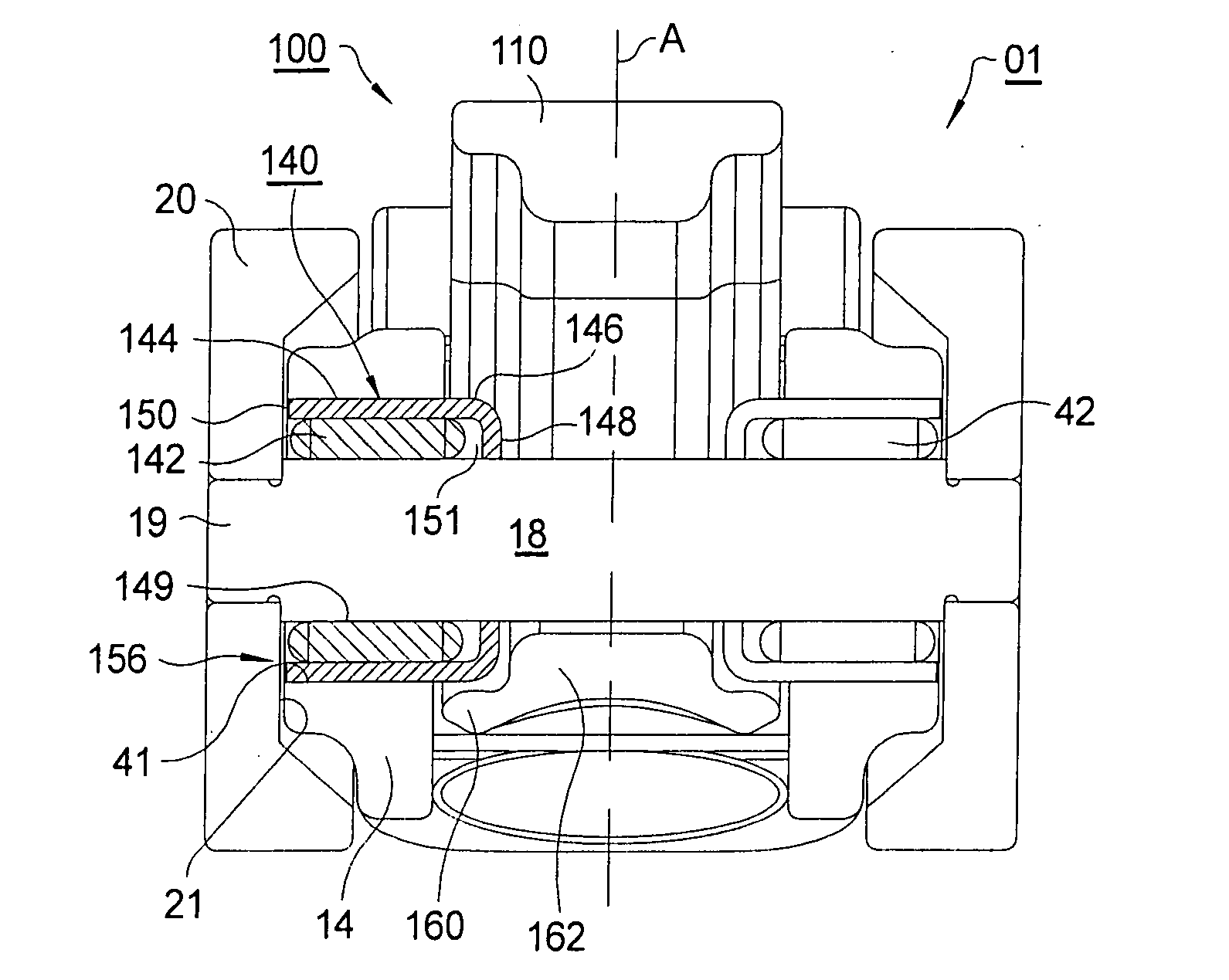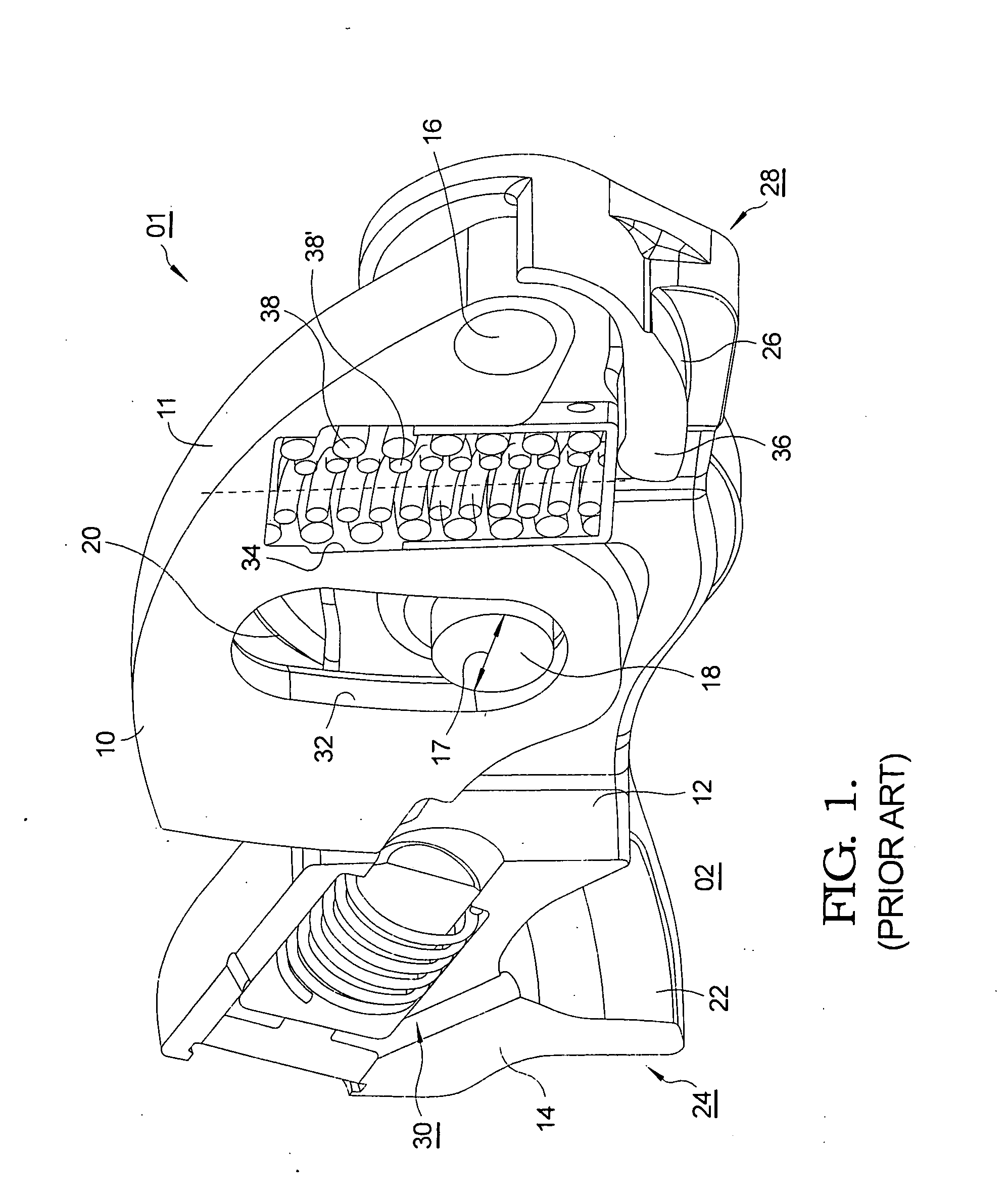Roller bearing and z-stop for a two-step roller finger follower
a roller bearing and roller finger follower technology, applied in the direction of valve arrangements, machines/engines, mechanical equipment, etc., can solve the problems of reducing the life and durability of the bearing, hla leakage, and affecting the operation of the valve train,
- Summary
- Abstract
- Description
- Claims
- Application Information
AI Technical Summary
Benefits of technology
Problems solved by technology
Method used
Image
Examples
first embodiment
[0034]RFF 100 of a first embodiment provides an improved roller shaft bearing that includes provisions for a mechanical z-stop to prevent leak down by limiting the amount of upward travel of the high-lift follower relative to the low-lift follower, as imposed by the lost motion spring, when the high-lift follower is on the base circle portion of the high-lift cam.
[0035]Referring to FIG. 5, the features shown to the left of split line A depict first embodiment 100 in accordance with the present invention, and the features shown to the right depict the equivalent prior art features 01 generally as shown in FIGS. 1-4 and discussed above. Bearing unit 140 includes cup shaped member 146 formed to include cylindrical portion 144, inside flange 148 and end surface 150. Note that the portion of cup member 146 near end surface 150 is open, that is, lacking in an enclosing flange as in the prior art. Bearing unit 140 also includes a plurality of needle bearings 142 received within cylindrical...
embodiment 200
[0039]Second RFF embodiment 200, shown in FIG. 6, also provides an improved roller shaft bearing that includes provisions for a mechanical z-stop. Two identical bearing units 240 each include cup member 246 formed to include cylindrical portion 244, inside flange 248, end flange 250, and nose portion 252. Each bearing unit 240 also includes a plurality of hardened needle bearings 242, substantially identical with bearings 142 in FIG. 5, received within cylindrical portion 244 of cup member 246. Unlike cup 46 where only a portion was hardened, cup member 246, like cup member 146, may be hardened in its entirety, including nose portion 252, since it is not necessary to roll over an end of cup member 246 to laterally retain needle bearings 242.
second embodiment
[0040]To assemble the second embodiment, each hardened cup member 246 is oriented so that outside flange 250 faces outward relative to the outward opening of shaft orifice 41. Then, a tool (not shown) is used to press against hardened outside flange 250 until the flange contacts an outside wall 253 of low-lift follower 14, pressing the cup member into place in direction 156 so that outside flange 250 will be positioned in close relationship with an inside surface 51 of roller 20. Then, roller shaft 18 is fitted through central opening 249 of each cup member 246 to thereby centrally align shaft 18 relative to cup member 246 to form an annular needle bearing chamber 251. Roller shaft 18 preferably is not in contact with the inner surfaces of nose portions 252. After needle bearings 242 are aligned and positioned within bearing chamber 251, rollers 20 are press-fittedly received by roller shaft ends 19, and optionally secured to shaft ends 19 by, for example, welding, bonding, riveting...
PUM
 Login to View More
Login to View More Abstract
Description
Claims
Application Information
 Login to View More
Login to View More - R&D
- Intellectual Property
- Life Sciences
- Materials
- Tech Scout
- Unparalleled Data Quality
- Higher Quality Content
- 60% Fewer Hallucinations
Browse by: Latest US Patents, China's latest patents, Technical Efficacy Thesaurus, Application Domain, Technology Topic, Popular Technical Reports.
© 2025 PatSnap. All rights reserved.Legal|Privacy policy|Modern Slavery Act Transparency Statement|Sitemap|About US| Contact US: help@patsnap.com



